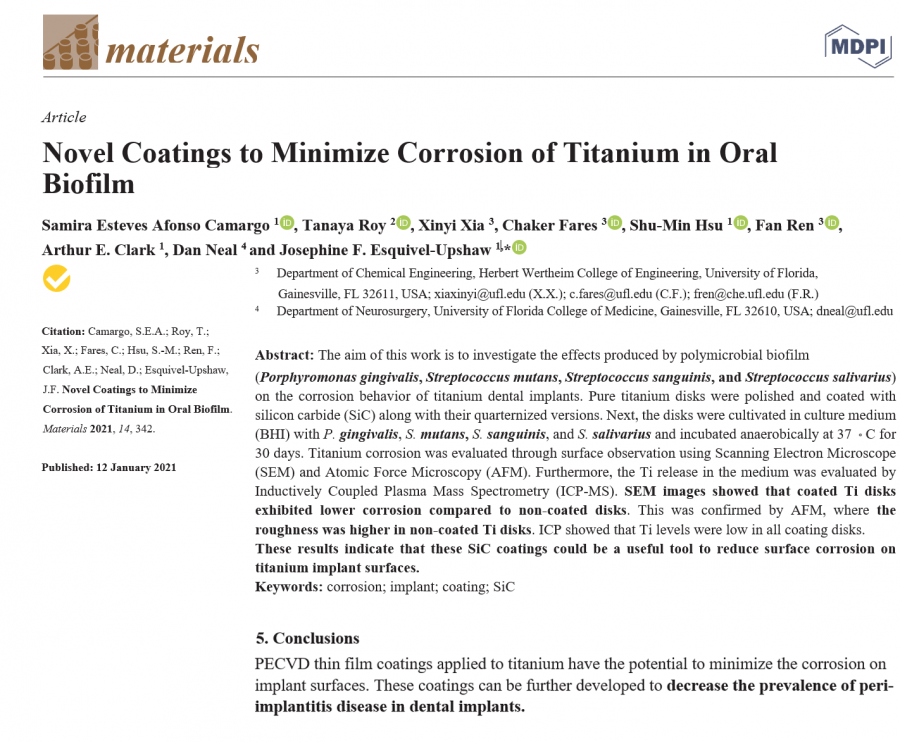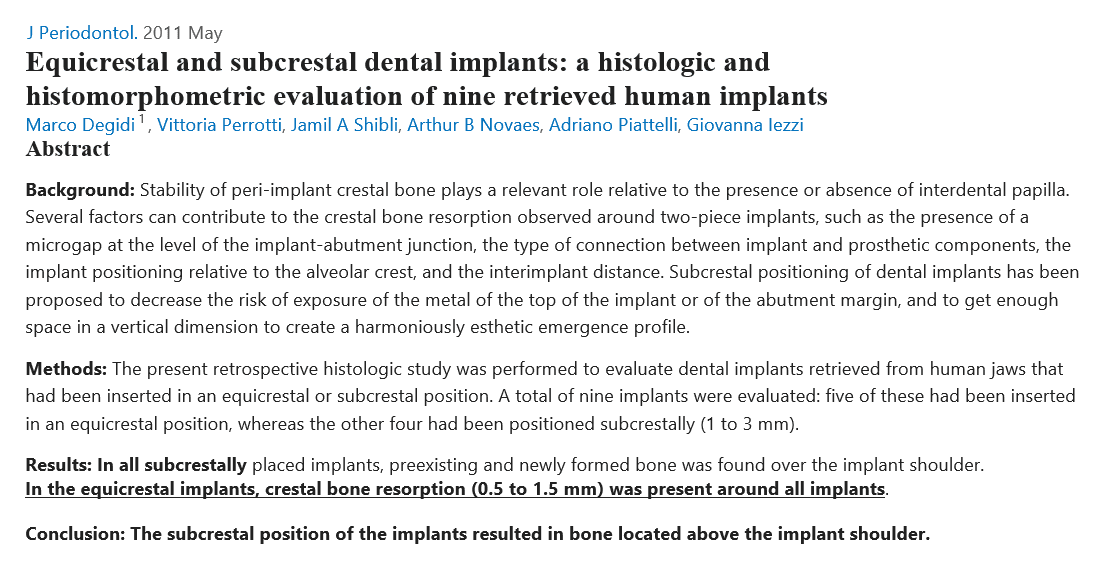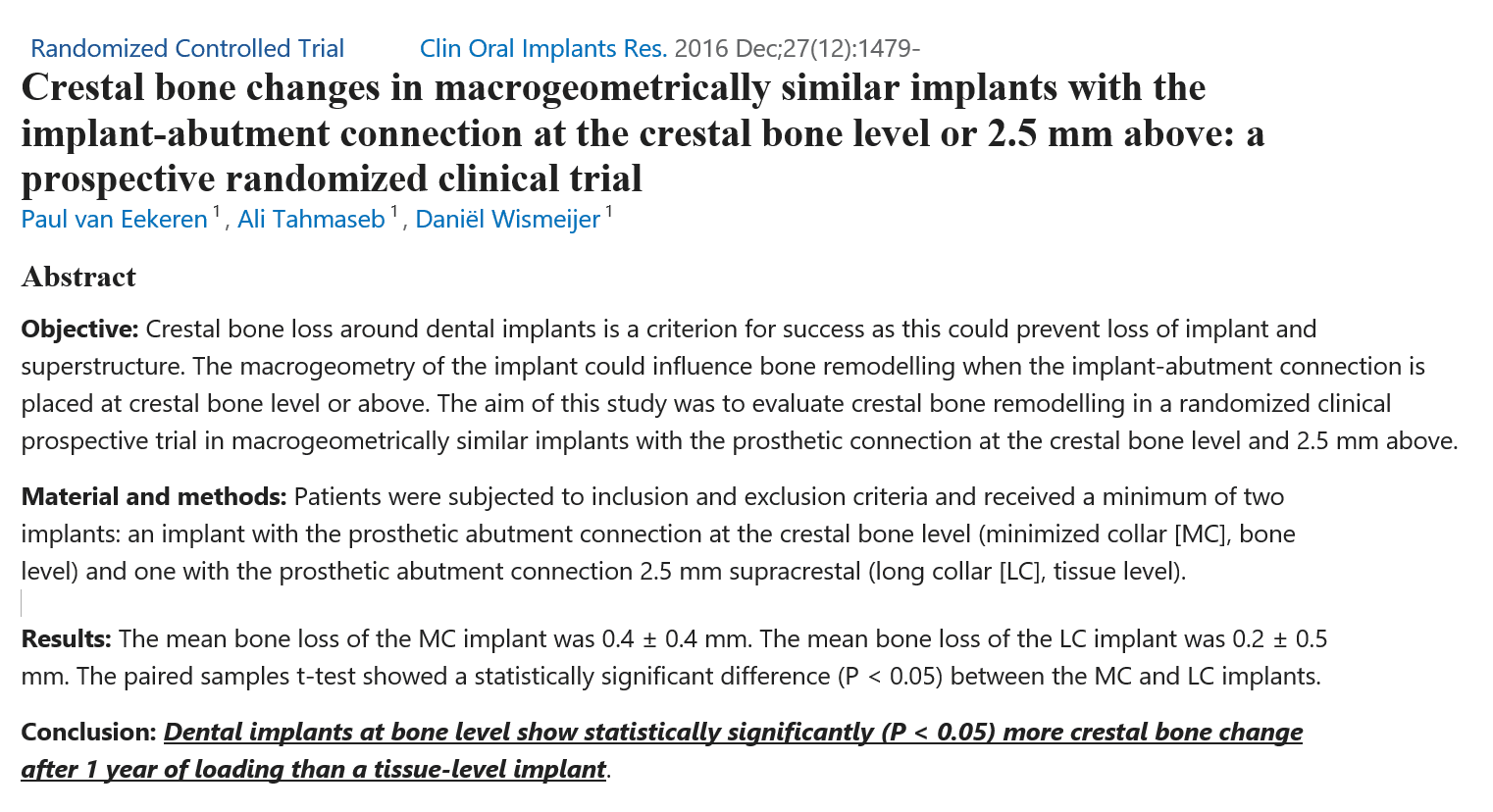
The next prospect in implant dentistry combines a smooth surface in the trans-mucosal area with a micro-rough surface inside the bone.
As observed in the Derks study, the risk of peri-implant complications is reduced using this combination of spatially specific smooth and rough surfaces.
Dentalis Tissue level implants bring together an inventive endosteal design and optimal stability to open a wide range of new clinical possibilities.
The next generation of Dentalis® offers a novel coating on their implants that minimizes bacterial adhesion and corrosion on implant surfaces,
without compromising the biocompatibility of titanium surfaces.
Studies have proven the benefits of this coating as holding anti-bacterial and osseointegration properties.
An in vitro assay showed that this coating decreases the biofilm formation of P. gingivalis (a common PI-causing bacteria) while maintaining biocompatibility.

DESIGNED FOR IMMEDIATE PROTOCOLS
- Fully tapered implant with deep threads and grove threads designed for optimized primary stability combined with the predictability of Tissue Level Implant
- A narrow implant diameter option, 3.25 mm for all indications.

PERI-IMPLANT HEALTH PRESERVATION
- Reduced risk of nesting bacteria
- Novel Coatings to Minimize Bacterial Adhesion, Immediate soft-tissue attachment preservation and Promote Osteoblast Activity for Titanium Implants

REAL CONFIDENCE
- USA precision and quality Titanium Grade 23 material and BAS® surface

- A one-stage process with restoration at soft-tissue level allows you to reduce chair time .
- Ease of restoration even in the posterior region, with the same type of restoration of the Bone level implants
- Highly efficient treatment protocol thanks to straightforward conventional and digitally integrated workflows




Dentalis Surface:
Surface roughness is achieved from “grit-blasting,” using a unique combination of the HA particles (soluble) with different sizes of grains. This process creates optimal structural roughness on the surface and enables the incorporation of biocompatible particles.
Roughness is measured with an average roughness (Ra), while the most commonly used parameter for describing roughness is calculated in microns. The rough surfaces produced by grit-blasting have irregular geometries with Ra value of 3.3 μm, which is considered optimal for the osseointegration process.
Raw Material:
All Dentalis implants are made of Ti 6Al-4V ELI that is a higher-purity (“extra-low interstitial”) version of Ti 6Al-4V, with lower specified limits on iron and the interstitial elements C and O. It is an alpha + beta alloy .Ti 6Al-4V ELI may be considered in any biomedical application, particularly for implantable components, because of its biocompatibility, good fatigue strength, and low modulus. Ti 6Al-4V ELI has been the material of choice due to its excellent biocompatibility. The ELI grade has superior damage tolerance (fracture toughness, fatigue crack growth rate) and better mechanical properties compared to standard grade Ti 6Al-4V.
Implant Range:
- | 4mm | 5mm | 6.5mm | 8mm | 10mm | 11.5mm | 13mm | 16mm | 18mm |
3.25mm | - | - | - | - | 113210 | 113211 | 113213 | 113216 | - |
3.75mm | - | - | - | 113708 | 113710 | 113711 | 113713 | 113719 | 113718 |
4.2mm | 114204 | 114205 | 114206 | 114208 | 114210 | 114211 | 114213 | 114216 | 114218 |
5.0mm | 115004 | 115005 | 115006 | 115010 | 115011 | 115013 | - | - |
Recommendation
to reduce the pressure in the bone around the implant neck:
Bone Type D1 use the last drill up to 1/3 depth.
Bone Type D2-3 use the last drill to the depth of the cortex.
Bone Type D4 use the one before last drill desirable to the depth
of the cortex For example: Implant diameter 3.25Ø in soft bone (D4)
use the 2.4 Ø drill as a final drill just for the cortex.
Procedures recommended by Dentalis cannot replace the judgment and professional experience of the surgeon.
| Drill Speed (RPM) | 900-1200 | 900-1200 | 800-1000 | 500-700 | 400-700 |
|---|---|---|---|---|---|
| Drill Diameter (mm) | ∅ 1.8 | ∅ 2 | ∅ 2.5 | ∅ 2.8 | ∅ 3.2 |

Recommendation
to reduce the pressure in the bone around the implant neck:
Bone Type D1 use the last drill up to 1/3 depth.
Bone Type D2-3 use the last drill to the depth of the cortex.
Bone Type D4 use the one before last drill desirable to the depth
of the cortex For example: Implant diameter 3.75Ø in soft bone
(D4) use the 2.8 Ø drill as a final drill just for the cortex.
Procedures recommended by Dentalis cannot replace the judgment and professional experience of the surgeon.
| Drill Speed (RPM) | 900-1200 | 900-1200 | 800-1000 | 500-700 | 400-700 | 400-600 |
|---|---|---|---|---|---|---|
| Drill Diameter (mm) | ∅ 1.8 | ∅ 2 | ∅ 2.5 | ∅ 2.8 | ∅ 3.2 | ∅ 3.6 |

Recommendation
to reduce the pressure in the bone around the implant neck:
Bone Type D1 use the last drill up to 1/3 depth.
Bone Type D2-3 use the last drill to the depth of the cortex.
Bone Type D4 use the one before last drill desirable to the
depth of the cortex For example: Implant diameter 3.75Ø
in soft bone (D4) use the 2.8 Ø drill as a final drill just for the cortex.
Procedures recommended by Dentalis cannot replace the judgment and professional experience of the surgeon.
| Drill Speed (RPM) | 900-1200 | 900-1200 | 800-1000 | 500-700 | 400-700 | 400-600 | 400-600 |
|---|---|---|---|---|---|---|---|
| Drill Diameter (mm) | ∅ 1.8 | ∅ 2 | ∅ 2.5 | ∅ 2.8 | ∅ 3.2 | ∅ 3.6 | ∅ 4.1 |

Recommendation
to reduce the pressure in the bone around the implant neck:
Bone Type D1 use the last drill up to 1/3 depth.
Bone Type D2-3 use the last drill to the depth of the cortex.
Bone Type D4 use the one before last drill desirable to the
depth of the cortex For example: Implant diameter 5.0Ø in
soft bone (D4) use the 3.6 Ø drill as a final drill just for the cortex.
Procedures recommended by Dentalis cannot replace the judgment and professional experience of the surgeon.
| Drill Speed (RPM) | 900-1200 | 900-1200 | 800-1000 | 500-700 | 400-700 | 400-600 | 400-600 | 300-500 |
|---|---|---|---|---|---|---|---|---|
| Drill Diameter (mm) | ∅ 1.8 | ∅ 2 | ∅ 2.5 | ∅ 2.8 | ∅ 3.2 | ∅ 3.6 | ∅ 4.1 | ∅ 4.6 |

Procedures recommended by DENTALIS cannot replace the judgment and professional experience of the surgeon.
Receive the latest news from Dentalis, including future live webinars, new product developments and clinical research.



For over two decades, Dentalis has led implant dentistry into a new era of attainability and aesthetics.
The pink tissue versatile implant neck combines superior
gingival aesthetics and high primary stability,
improved placement, and temporization,
which is particularly beneficial in
aesthetically demanding cases.
REFERENCES:
1.Bittner N, Schulze-Späte U, Cleber S, Da Silva J, Kim D, Tarnow D, Ishikawa-Nagai S, Gil M. Comparison of Peri-implant Soft Tissue Color with the Use of Pink-Neck vs Gray Implants and Abutments Based on Soft Tissue Thickness:
A 6-Month Follow-up Study. Int J Prosthodont. 2020Jan/Feb;33(1):29-38.
2. Gil M, Ishikawa-Nagai S, Elani H, Da Silva J, Kim D, Tarnow D, Schulze-Späte U, Cleber S, Bittner N. Comparison of the Color Appearance of Peri-implant Soft Tissue with Natural Gingiva Using Anodized Pink-Neck Implants and Pink Abutments: A Prospective Clinical Trial. Int J Oral Maxillofac Implants. 2019 May/June;34(3):752–758.
3.Gil M, Ishikawa-Nagai S, Elani H. A prospective clinical trial to assess the optical efficacy of pink neck implants and pink abutments on soft tissue aesthetics. J Esthet Restor Dent. 2017;29(6):1-7.38.
For over two decades, Dentalis has led implant dentistry into a new era of attainability and aesthetics.
The pink tissue versatile implant neck combines superior gingival aesthetics and high primary stability, improved placement, and temporization, which is particularly beneficial in aesthetically demanding cases.

REFERENCES:
1.Bittner N, Schulze-Späte U, Cleber S, Da Silva J, Kim D, Tarnow D, Ishikawa-Nagai S, Gil M. Comparison of Peri-implant Soft Tissue Color with the Use of Pink-Neck vs Gray Implants and Abutments Based on Soft Tissue Thickness:
A 6-Month Follow-up Study. Int J Prosthodont. 2020Jan/Feb;33(1):29-38.
2. Gil M, Ishikawa-Nagai S, Elani H, Da Silva J, Kim D, Tarnow D, Schulze-Späte U, Cleber S, Bittner N. Comparison of the Color Appearance of Peri-implant Soft Tissue with Natural Gingiva Using Anodized Pink-Neck Implants and Pink Abutments: A Prospective Clinical Trial. Int J Oral Maxillofac Implants. 2019 May/June;34(3):752–758.
3.Gil M, Ishikawa-Nagai S, Elani H. A prospective clinical trial to assess the optical efficacy of pink neck implants and pink abutments on soft tissue aesthetics. J Esthet Restor Dent. 2017;29(6):1-7.38.
Contacts
The combination of innovative surface technology with 344% stronger bone reduces marginal bone loss and provides for a higher BIC%, decreasing the risk of peri-implant disease.
The enhanced deep thread simplifies the insertion and allows for high primary stability.
For over two decades, Dentalis has led implant dentistry into a new era of attainability and aesthetics

